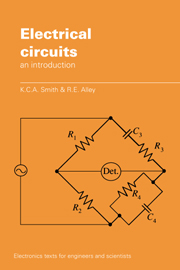An Analog Electronics Companion
Engineers and scientists frequently find themselves having to get involved in electronic circuit design even though this may not be their specialty. This book is specifically designed for these situations, and has two major advantages for the inexperienced designer: it assumes little prior knowledge of electronics and it takes a modular approach, so you can find just what you need without working through a whole chapter. The first three parts of the book start by refreshing the basic mathematics and physics needed to understand circuit design. Part four discusses individual components (resistors, capacitors etc.), while the final and largest section describes commonly encountered circuit elements such as differentiators, oscillators, filters and couplers. A major bonus and learning aid is the inclusion of a CD-ROM with the student edition of the PSpice simulation software, together with models of most of the circuits described in the book.
- Modular approach - learn the bits you want, ignore the bits you don't
- Includes fully functional PSpice student edition simulation software and lots of example circuits
- Assumes no prior knowledge of electronics - starting from the basic mathematics and physics behind circuit design
Reviews & endorsements
'… The subjects are treated in a concise, clear and self-contained fashion, always helped by a broad exhaustive bibliography, and cover all the necessary aspects for electronic design …'. Measurement Science and Technology
'I enthusiastically endorse the book, particularly to those who have never benefited from the simulation experience.' Physics Today
'… It is an excellent compendium of most mathematical and physical aspects of electronic circuits … [It is] a pleasure to read and a worthwhile complement to books on electronic design.' Professor Willy Sansen, KU Leuven
'An Analog Electronics Companion is an informative and up-to-date guide to this traditional sector of the electronic colossus. It has that most desirable, and all-too rare asset of being an entertaining read … [It] is much more than an overview of basic electronics for the general reader … I think most engineering professionals, and that includes most electronic engineers, will find it a very useful and handy reference book.' Steve Cripps, Hywave Associates
'Particularly useful for the student is the inclusion of a CD-ROM containing PSpice circuit simulation software, with numerous examples as discussed throughout the body of the text. All in all this book provides a clear and easy to understand discussion of analog electronic circuit design suitable for the new student or as a handy reference for more expert scientists.' Contemporary Physics
Product details
June 2007Paperback
9780521687805
668 pages
250 × 175 × 35 mm
1.34kg
465 b/w illus.
Available
Table of Contents
- Preface
- List of symbols
- Part I. Mathematics: Introduction
- 1.1 Trigonometry
- 1.2 Geometry
- 1.3 Series expansions
- 1.4 Logarithms
- 1.5 Exponentials
- 1.6 Vectors
- 1.7 Complex numbers
- 1.8 Differentiation
- 1.9 Integration
- 1.10 Equations and determinants
- 1.11 Fourier transforms
- 1.12 Laplace transforms
- 1.13 Differential equations
- 1.14 Convolution
- Part II. Physics: Introduction
- 2.1 Current flow
- 2.2 Energies
- 2.3 Kirchhoff's laws
- 2.4 Faraday's law
- 2.5 Electric and magnetic fields
- 2.6 Magnetism and relativity
- 2.7 Maxwell's equations
- 2.8 Skin effect
- 2.9 Quantization
- 2.10 Dielectrics and permittivity
- 2.11 Magnetic materials
- 2.12 Units of electromagnetism
- 2.13 Noise
- Part III. Circuit Mathematics: Introduction
- 3.1 Circuit laws
- 3.2 A.C. theory
- 3.3 Phasors
- 3.4 Phase and amplitude
- 3.5 Resonance
- 3.6 Bandwidth and risetime
- 3.7 Pulse and transient response
- 3.8 Equivalent circuits
- 3.9 Dispersion and absorption
- 3.10 Feedback
- 3.11 Noise in circuits
- 3.12 Hysteresis
- 3.13 Bridges
- 3.14 Approximation
- 3.15 Control systems
- 3.16 Filters
- 3.17 Transmission lines
- Part IV. Circuit Elements: Introduction
- 4.1 Resistors
- 4.2 Capacitors
- 4.3 Inductors
- 4.4 Transformers
- 4.5 Diodes
- 4.6 Bipolar transistors
- 4.7 Field effect transistors
- 4.8 Temperature dependent resistors
- 4.9 Coaxial cables
- 4.10 Crystals
- Part V. SPICE Circuits: Introduction
- 5.1 Absolute value circuit
- 5.2 Oscilloscope probes
- 5.3 Operational amplifier circuits
- 5.4 Rectifier circuits
- 5.5 Integrator
- 5.6 Differentiator
- 5.7 Two-phase oscillator
- 5.8 Wien-Bridge oscillator
- 5.9 Current sources and mirrors
- 5.10 Power supplies
- 5.11 Current-feedback amplifiers
- 5.12 Fast operational picoammeter
- 5.13 Three-pole, single amplifier filter
- 5.14 Open-loop response
- 5.15 Lumped or distributed?
- 5.16 Immittance through the looking glass: gyrators, frequency dependent negative resistors and negative immittance converters
- 5.17 Maser gain simulation
- 5.18 Frequency independent phase shifter
- 5.19 Ratemeter
- 5.20 Baluns and high frequency transformers
- 5.21 Directional coupler
- 5.22 Power control or hotswitch
- 5.23 Modulation control of a resonant circuit
- 5.24 Photomultiplier gating circuit
- 5.25 Transatlantic telegraph cable
- 5.26 Chaos
- 5.27 Spice
- Notes
- Bibliography
- Index.





